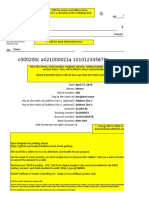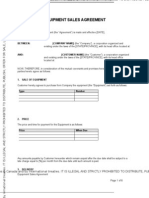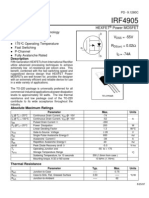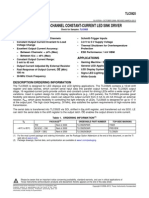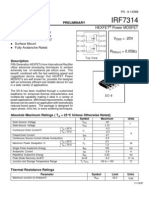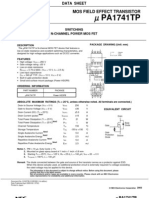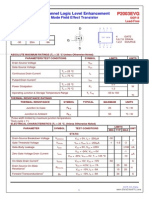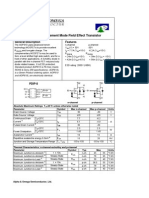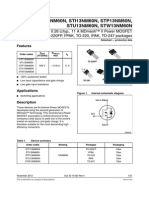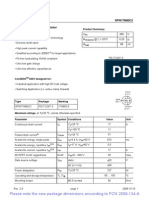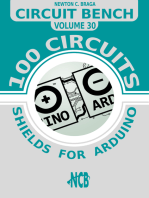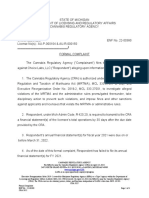Synchronous Buck Nexfet™ Power Block: Features Description
Synchronous Buck Nexfet™ Power Block: Features Description
Uploaded by
Walter Apaza TiconaCopyright:
Available Formats
Synchronous Buck Nexfet™ Power Block: Features Description
Synchronous Buck Nexfet™ Power Block: Features Description
Uploaded by
Walter Apaza TiconaOriginal Title
Copyright
Available Formats
Share this document
Did you find this document useful?
Is this content inappropriate?
Copyright:
Available Formats
Synchronous Buck Nexfet™ Power Block: Features Description
Synchronous Buck Nexfet™ Power Block: Features Description
Uploaded by
Walter Apaza TiconaCopyright:
Available Formats
Output Current (A)
E
f
f
i
c
i
e
n
c
y
(
%
)
P
o
w
e
r
L
o
s
s
(
W
)
0 5 10 15 20
50 0
60 1
70 2
80 3
90 4
100 5
G029
V
GS
= 5V
V
IN
= 12V
V
OUT
= 1.3V
f
SW
= 500kHz
L
OUT
= 1H
T
A
= 25C
Efficiency
Power Loss
G
1R
D
1
S
2
D /S
2 1
G
1
G
2
S0474-04
ENABLE
ENABLE
PWM
GND
BST
DRVH
LL
DRVL
CSD86330Q3D Driver IC
V
DD
V
I
V
O
V
DD
Control
FET
Sync
FET
PWM
P0116-01
1
2
3 V
SW
V
SW
V
SW
4 B
G 5 T
GR
6 T
G
P
GND
(Pin 9)
7 V
IN
8 V
IN
C S D 8 6 3 3 0 Q 3 D
www.ti.com SLPS264C OCTOBER 2010 REVISED OCTOBER 2011
S y n ch r on ou s B u ck N e x F E T P owe r B l ock
1F E AT URE S D E S C RIP T ION
The CSD86330Q3D NexFET power block is an
2 Hal f-B r idge P owe r B l ock
optimized design for synchronous buck applications
90 % S y s te m E fficie n cy at 15A
offering high current, high efficiency, and high
Up T o 20 A Ope r ation
frequency capability in a small 3.3-mm 3.3-mm
outline. Optimized for 5V gate drive applications, this
High F r e qu e n cy Ope r ation (Up T o 1.5MHz)
product offers a flexible solution capable of offering a
High D e n s ity S ON 3 .3 -mm 3 .3 -mm
high density power supply when paired with any 5V
F ootpr in t
gate drive froman external controller/driver.
Optimize d for 5V Gate D r ive
T E XT AD D E D F OR S P AC IN G
Low S witch in g Los s e s
T op Vie w
Ul tr a Low In du ctan ce P ack age
RoHS C ompl ian t
Hal oge n F r e e
P b-F r e e T e r min al P l atin g
AP P LIC AT ION S
S y n ch r on ou s B u ck C on ve r te r s
High F r e qu e n cy Appl ication s
T E XT AD D E D F OR S P AC IN G
ORD E RIN G IN F ORMAT ION
High C u r r e n t, Low D u ty C y cl e Appl ication s
D e vice P ack age Me dia Q ty S h ip
Mu l tiph as e S y n ch r on ou s B u ck C on ve r te r s
SON 3.3-mm3.3- 13-Inch Tape and
CSD86330Q3D 2500
P OL D C -D C C on ve r te r s mmPlastic Package Reel Reel
IMVP , VRM, an d VRD Appl ication s
TEXT ADDED FOR SPACING
TEXT ADDED FOR SPACING
TEXT ADDED FOR SPACING
T YP IC AL P OWE R B LOC K E F F IC IE N C Y
T YP IC AL C IRC UIT an d P OWE R LOS S
1
Please be aware that an important notice concerning availability, standard warranty, and use in critical applications of
Texas Instruments semiconductor products and disclaimers thereto appears at the end of this data sheet.
2NexFET is a trademark of Texas Instruments.
PRODUCTION DATA information is current as of publication date.
Copyright 20102011, Texas Instruments Incorporated
Products conform to specifications per the terms of the Texas
Instruments standard warranty. Production processing does not
necessarily include testing of all parameters.
C S D 8 6 3 3 0 Q 3 D
SLPS264C OCTOBER 2010 REVISED OCTOBER 2011 www.ti.com
These devices have limited built-in ESD protection. The leads should be shorted together or the device placed in conductive foam
during storage or handling to prevent electrostatic damage to the MOS gates.
AB S OLUT E MAXIMUM RAT IN GS
T
A
=25C (unless otherwise noted)
(1)
P ar ame te r C on dition s VALUE UN IT
V
IN
to P
GND
0.8 to 25 V
Voltage range T
G
to T
GR
8 to 10 V
B
G
to P
GND
8 to 10 V
Pulsed Current Rating, I
DM
60 A
Power Dissipation, P
D
6 W
Sync FET, I
D
=65A, L =0.1mH 211
Avalanche Energy E
AS
mJ
Control FET, I
D
=42A, L =0.1mH 88
Operating J unction and Storage Temperature Range, T
J
, T
STG
55 to 150 C
(1) Stresses beyond those listed under Absolute MaximumRatings may cause permanent damage to the device. These are stress ratings
only, and functional operation of the device at these or any other conditions beyond those indicated is not implied. Exposure to absolute-
maximum-rated conditions for extended periods may affect device reliability.
RE C OMME N D E D OP E RAT IN G C ON D IT ION S
T
A
=25 (unless otherwise noted)
P ar ame te r C on dition s MIN MAX UN IT
Gate Drive Voltage, V
GS
4.5 8 V
Input Supply Voltage, V
IN
22 V
Switching Frequency, f
SW
C
BST
=0.1F (min) 200 1500 kHz
Operating Current 20 A
Operating Temperature, T
J
125 C
P OWE R B LOC K P E RF ORMAN C E
T
A
=25 (unless otherwise noted)
P ar ame te r C on dition s MIN T YP MAX UN IT
V
IN
=12V, V
GS
=5V,
V
OUT
=1.3V, I
OUT
=15A ,
Power Loss, P
LOSS
(1)
1.9 W
f
SW
=500kHz,
L
OUT
=1H, T
J
=25C
T
G
to T
GR
=0V
V
IN
Quiescent Current, I
QVIN
10 A
B
G
to P
GND
=0V
(1) Measurement made with six 10-F (TDK C3216X5R1C106KT or equivalent) ceramic capacitors placed across V
IN
to P
GND
pins and
using a high current 5V driver IC.
T HE RMAL IN F ORMAT ION
T
A
=25C (unless otherwise stated)
T HE RMAL ME T RIC MIN T YP MAX UN IT
J unction to ambient thermal resistance (Min Cu)
(1)
135
R
J A
J unction to ambient thermal resistance (Max Cu)
(1)(2)
73
C/W
J unction to case thermal resistance (Top of package)
(1)
29
R
J C
J unction to case thermal resistance (P
GND
Pin)
(1)
2.5
(1) R
J C
is determined with the device mounted on a 1-inch
2
(6.45-cm
2
), 2 oz. (0.071-mmthick) Cu pad on a 1.5-inch 1.5-inch
(3.81-cm3.81-cm), 0.06-inch (1.52-mm) thick FR4 board. R
J C
is specified by design while R
J A
is determined by the users board
design.
(2) Device mounted on FR4 material with 1-inch
2
(6.45-cm
2
) Cu.
2 Submit Documentation Feedback Copyright 20102011, Texas Instruments Incorporated
HD
HG
LG
LD
M0205-01
8
6
3
3
0
Q
3
D
3
3
x
3
3
M
I
N
R
e
v
0
.
.
LS
HS
HD
HG
LG
LD
M0206-01
8
6
3
3
0
Q
3
D
3
3
x
3
3
M
I
N
R
e
v
0
.
.
LS
HS
C S D 8 6 3 3 0 Q 3 D
www.ti.com SLPS264C OCTOBER 2010 REVISED OCTOBER 2011
E LE C T RIC AL C HARAC T E RIS T IC S
T
A
=25C (unless otherwise stated)
Q 1 C on tr ol F E T Q 2 S y n c F E T
P ARAME T E R T E S T C ON D IT ION S
MIN T YP MAX MIN T YP MAX UN IT
S tatic C h ar acte r is tics
BV
DSS
Drain to Source Voltage V
GS
=0V, I
DS
=250A 25 25 V
Drain to Source Leakage
I
DSS
V
GS
=0V, V
DS
=20V 1 1 A
Current
Gate to Source Leakage
I
GSS
V
DS
=0V, V
GS
=+10 / 8 100 100 nA
Current
Gate to Source Threshold
V
GS(th)
V
DS
=V
GS
, I
DS
=250A 0.9 1.4 2.1 0.9 1.1 1.6 V
Voltage
V
IN
=12V, V
GS
=5V,
V
OUT
=1.3V, I
OUT
=15A,
Z
DS(on)
Effective AC On-Impedance 8.8 3.3 m
f
SW
=500kHz,
L
OUT
=1H
g
fs
Transconductance V
DS
=15V, I
DS
=14A 52 82 S
D y n amic C h ar acte r is tics
C
ISS
Input Capacitance
(1)
710 920 1280 1660 pF
C
OSS
Output Capacitance
(1)
V
GS
=0V, V
DS
=12.5V, 350 455 680 880 pF
f =1MHz
Reverse Transfer
C
RSS
18 23 38 49 pF
Capacitance
(1)
R
G
Series Gate Resistance
(1)
1.5 3.0 1.2 2.4
Q
g
Gate Charge Total (4.5V)
(1)
4.8 6.2 9.2 12 nC
Q
gd
Gate Charge - Gate to Drain 0.9 1.6 nC
V
DS
=12.5V,
Gate Charge - Gate to
I
DS
=14A
Q
gs
1.6 2.1 nC
Source
Q
g(th)
Gate Charge at Vth 0.9 1.2 nC
Q
OSS
Output Charge V
DS
=15.5V, V
GS
=0V 7.2 13.6 nC
t
d(on)
Turn On Delay Time 4.9 5.3 ns
t
r
Rise Time 7.5 6.3 ns
V
DS
=12.5V, V
GS
=4.5V,
I
DS
=14A, R
G
=2
t
d(off)
Turn Off Delay Time 8.5 15.8 ns
t
f
Fall Time 1.9 4.2 ns
D iode C h ar acte r is tics
V
SD
Diode Forward Voltage I
DS
=14A, V
GS
=0V 0.85 1 0.8 1 V
Q
rr
Reverse Recovery Charge 3.9 7.3 nC
V
dd
=15.5V, I
F
=14A,
di/dt =300A/s
t
rr
Reverse Recovery Time 13.9 19 ns
(1) Specified by design
Max R
J A
=76C/W Max R
J A
=140C/W
when mounted on when mounted on
1 inch
2
(6.45 cm
2
) of 2- minimumpad area of
oz. (0.071-mmthick) 2-oz. (0.071-mmthick)
Cu. Cu.
Copyright 20102011, Texas Instruments Incorporated Submit Documentation Feedback 3
Board Temperature (C)
O
u
t
p
u
t
C
u
r
r
e
n
t
(
A
)
0 20 40 60 80 100 120 140
0
5
10
15
20
25
G005
Ambient Temperature (C)
O
u
t
p
u
t
C
u
r
r
e
n
t
(
A
)
0 10 20 30 40 50 60 70 80 90
0
5
10
15
20
25
G003
400LFM
200LFM
100LFM
Nat Conv
Ambient Temperature (C)
O
u
t
p
u
t
C
u
r
r
e
n
t
(
A
)
0 10 20 30 40 50 60 70 80 90
0
5
10
15
20
25
G004
400LFM
200LFM
100LFM
Nat Conv
Output Current (A)
P
o
w
e
r
L
o
s
s
(
W
)
0 2 4 6 8 10 12 14 16 18 20
0
0.5
1
1.5
2
2.5
3
3.5
4
G001
Junction Temperature ( C)
P
o
w
e
r
L
o
s
s
,
N
o
r
m
a
l
i
z
e
d
-50 -25 0 25 50 75 100 125 150
0.5
0.6
0.7
0.8
0.9
1
1.1
1.2
G002
C S D 8 6 3 3 0 Q 3 D
SLPS264C OCTOBER 2010 REVISED OCTOBER 2011 www.ti.com
T YP IC AL P OWE R B LOC K D E VIC E C HARAC T E RIS T IC S
Test Conditions: V
IN
=12V, V
DD
=5V, f
SW
=500kHz, V
OUT
=1.2V, L
OUT
=1.0H, I
OUT
=20A, T
J
=125C, unless stated
otherwise.
F igu r e 1. P owe r Los s vs Ou tpu t C u r r e n t F igu r e 2. P owe r Los s vs T e mpe r atu r e
F igu r e 3 . S afe Ope r atin g Ar e a P C B Ve r tical Mou n t
(1)
F igu r e 4. S afe Ope r atin g Ar e a P C B Hor izon tal Mou n t
(1)
F igu r e 5. T y pical S afe Ope r atin g Ar e a
(1)
(1) The Typical Power Block System Characteristic curves are based on measurements made on a PCB design with
dimensions of 4.0(W) 3.5(L) 0.062(H) and 6 copper layers of 1 oz. copper thickness. See Application Section
for detailed explanation.
4 Submit Documentation Feedback Copyright 20102011, Texas Instruments Incorporated
Output Voltage (V)
P
o
w
e
r
L
o
s
s
,
N
o
r
m
a
l
i
z
e
d
0.6 1.2 1.8 2.4 3 3.6 4.2 4.8 5.4
0.6
0.7
0.8
0.9
1
1.1
1.2
1.3
1.4
1.5
1.6
-10.5
-7.9
-5.2
-2.6
0
2.6
5.2
7.9
10.5
13.1
15.7
G008
S
O
A
T
e
m
p
e
r
a
t
u
r
e
A
d
j
(
C
)
Output Inductance (H)
P
o
w
e
r
L
o
s
s
,
N
o
r
m
a
l
i
z
e
d
0 0.1 0.2 0.3 0.4 0.5 0.6 0.7 0.8 0.9 1 1.1
0.6
0.7
0.8
0.9
1
1.1
1.2
1.3
1.4
1.5
1.6
-10.5
-7.9
-5.2
-2.6
0
2.6
5.2
7.9
10.5
13.1
15.7
G009
S
O
A
T
e
m
p
e
r
a
t
u
r
e
A
d
j
(
C
)
Switching Frequency (kHz)
P
o
w
e
r
L
o
s
s
,
N
o
r
m
a
l
i
z
e
d
200 400 600 800 1000 1200 1400 1600
0.6
0.7
0.8
0.9
1
1.1
1.2
1.3
1.4
1.5
1.6
-10.5
-7.9
-5.2
-2.6
0
2.6
5.2
7.9
10.5
13.1
15.7
G006
S
O
A
T
e
m
p
e
r
a
t
u
r
e
A
d
j
(
C
)
Input Voltage (V)
P
o
w
e
r
L
o
s
s
,
N
o
r
m
a
l
i
z
e
d
3 6 9 12 15 18 21 24
0.6
0.7
0.8
0.9
1
1.1
1.2
1.3
1.4
1.5
1.6
-10.5
-7.8
-5.2
-2.6
0
2.6
5.2
7.8
10.5
13.1
15.7
G007
S
O
A
T
e
m
p
e
r
a
t
u
r
e
A
d
j
(
C
)
C S D 8 6 3 3 0 Q 3 D
www.ti.com SLPS264C OCTOBER 2010 REVISED OCTOBER 2011
T YP IC AL P OWE R B LOC K D E VIC E C HARAC T E RIS T IC S (con tin u e d)
Test Conditions: V
IN
=12V, V
DD
=5V, f
SW
=500kHz, V
OUT
=1.2V, L
OUT
=1.0H, I
OUT
=20A, T
J
=125C, unless stated
otherwise.
T E XT AD D E D F OR S P AC IN G T E XT AD D E D F OR S P AC IN G
F igu r e 6 . N or mal ize d P owe r Los s vs S witch in g F r e qu e n cy F igu r e 7. N or mal ize d P owe r Los s vs In pu t Vol tage
T E XT AD D E D F OR S P AC IN G T E XT AD D E D F OR S P AC IN G
F igu r e 8 . N or mal ize d P owe r Los s vs . Ou tpu t Vol tage F igu r e 9. N or mal ize d P owe r Los s vs . Ou tpu t In du ctan ce
Copyright 20102011, Texas Instruments Incorporated Submit Documentation Feedback 5
Q
g
- Gate Charge - nC
V
G
S
-
G
a
t
e
-
t
o
-
S
o
u
r
c
e
V
o
l
t
a
g
e
-
V
0 2 4 6 8
0
1
2
3
4
5
6
7
8
G014
I
D
= 14A
V
DS
= 12.5V
Q
g
- Gate Charge - nC
V
G
S
-
G
a
t
e
-
t
o
-
S
o
u
r
c
e
V
o
l
t
a
g
e
-
V
0 3 6 9 12 15
0
1
2
3
4
5
6
7
8
G015
I
D
= 14A
V
DS
= 12.5V
V
GS
- Gate-to-Source Voltage - V
I
D
S
-
D
r
a
i
n
-
t
o
-
S
o
u
r
c
e
C
u
r
r
e
n
t
-
A
1 1.5 2 2.5 3 3.5
0.001
0.01
0.1
1
10
100
T
C
= -55C
T
C
= 25C
T
C
= 125C
G012
V
DS
= 5V
V
GS
- Gate-to-Source Voltage - V
I
D
S
-
D
r
a
i
n
-
t
o
-
S
o
u
r
c
e
C
u
r
r
e
n
t
-
A
0.5 0.75 1 1.25 1.5 1.75 2 2.25 2.5
0.001
0.01
0.1
1
10
100
T
C
= -55C
T
C
= 25C
T
C
= 125C
G013
V
DS
= 5V
V
DS
- Drain-to-Source Voltage - V
I
D
S
-
D
r
a
i
n
-
t
o
-
S
o
u
r
c
e
C
u
r
r
e
n
t
-
A
0 0.2 0.4 0.6 0.8 1
0
10
20
30
40
50
60
V
GS
= 4.5V
V
GS
= 6V
V
GS
= 8V
G010
V
DS
- Drain-to-Source Voltage - V
I
D
S
-
D
r
a
i
n
-
t
o
-
S
o
u
r
c
e
C
u
r
r
e
n
t
-
A
0 0.05 0.1 0.15 0.2 0.25 0.3
0
10
20
30
40
50
60
V
GS
= 4.5V
V
GS
= 6V
V
GS
= 8V
G011
C S D 8 6 3 3 0 Q 3 D
SLPS264C OCTOBER 2010 REVISED OCTOBER 2011 www.ti.com
T YP IC AL P OWE R B LOC K MOS F E T C HARAC T E RIS T IC S
T
A
=25C, unless stated otherwise.
T E XT AD D E D F OR S P AC IN G T E XT AD D E D F OR S P AC IN G
F igu r e 10 . C on tr ol MOS F E T S atu r ation F igu r e 11. S y n c MOS F E T S atu r ation
T E XT AD D E D F OR S P AC IN G T E XT AD D E D F OR S P AC IN G
F igu r e 12. C on tr ol MOS F E T T r an s fe r F igu r e 13 . S y n c MOS F E T T r an s fe r
T E XT AD D E D F OR S P AC IN G T E XT AD D E D F OR S P AC IN G
F igu r e 14. C on tr ol MOS F E T Gate C h ar ge F igu r e 15. S y n c MOS F E T Gate C h ar ge
6 Submit Documentation Feedback Copyright 20102011, Texas Instruments Incorporated
V
GS
- Gate-to-Source Voltage - V
R
D
S
(
o
n
)
-
O
n
-
S
t
a
t
e
R
e
s
i
s
t
a
n
c
e
-
m
0 1 2 3 4 5 6 7 8 9 10
0
5
10
15
20
25
T
C
= 25C
T
C
= 125C
G020
I
D
= 14A
V
GS
- Gate-to-Source Voltage - V
R
D
S
(
o
n
)
-
O
n
-
S
t
a
t
e
R
e
s
i
s
t
a
n
c
e
-
m
0 1 2 3 4 5 6 7 8 9 10
0
2
4
6
8
10
12
14
16
T
C
= 25C
T
C
= 125C
G021
I
D
= 14A
T
C
- Case Temperature - C
V
G
S
(
t
h
)
-
T
h
r
e
s
h
o
l
d
V
o
l
t
a
g
e
-
V
-75 -25 25 75 125 175
0
0.2
0.4
0.6
0.8
1
1.2
1.4
1.6
1.8
G018
I
D
= 250A
T
C
- Case Temperature - C
V
G
S
(
t
h
)
-
T
h
r
e
s
h
o
l
d
V
o
l
t
a
g
e
-
V
-75 -25 25 75 125 175
0
0.2
0.4
0.6
0.8
1
1.2
1.4
1.6
1.8
G019
I
D
= 250A
V
DS
- Drain-to-Source Voltage - V
C
-
C
a
p
a
c
i
t
a
n
c
e
-
n
F
0 5 10 15 20 25
0.001
0.01
0.1
1
10
C
iss
= C
gd
+ C
gs
C
oss
= C
ds
+ C
gd
C
rss
= C
gd
G016
f = 1MHz
V
GS
= 0V
V
DS
- Drain-to-Source Voltage - V
C
-
C
a
p
a
c
i
t
a
n
c
e
-
n
F
0 5 10 15 20 25
0.01
0.1
1
10
C
iss
= C
gd
+ C
gs
C
oss
= C
ds
+ C
gd
C
rss
= C
gd
G017
f = 1MHz
V
GS
= 0V
C S D 8 6 3 3 0 Q 3 D
www.ti.com SLPS264C OCTOBER 2010 REVISED OCTOBER 2011
T YP IC AL P OWE R B LOC K MOS F E T C HARAC T E RIS T IC S (con tin u e d)
T
A
=25C, unless stated otherwise.
T E XT AD D E D F OR S P AC IN G T E XT AD D E D F OR S P AC IN G
F igu r e 16 . C on tr ol MOS F E T C apacitan ce F igu r e 17. S y n c MOS F E T C apacitan ce
T E XT AD D E D F OR S P AC IN G T E XT AD D E D F OR S P AC IN G
F igu r e 18 . C on tr ol MOS F E T V
GS (th )
F igu r e 19. S y n c MOS F E T V
GS (th )
T E XT AD D E D F OR S P AC IN G T E XT AD D E D F OR S P AC IN G
F igu r e 20 . C on tr ol MOS F E T R
D S (on )
vs V
GS
F igu r e 21. S y n c MOS F E T R
D S (on )
vs V
GS
Copyright 20102011, Texas Instruments Incorporated Submit Documentation Feedback 7
t
(AV)
- Time in Avalanche - ms
I
(
A
V
)
-
P
e
a
k
A
v
a
l
a
n
c
h
e
C
u
r
r
e
n
t
-
A
0.01 0.1 1 10
1
10
100
T
C
= 25C
T
C
= 125C
G026
I
(AV)
= t
(AV)
(0.021 L)
t
(AV)
- Time in Avalanche - ms
I
(
A
V
)
-
P
e
a
k
A
v
a
l
a
n
c
h
e
C
u
r
r
e
n
t
-
A
0.01 0.1 1 10
1
10
100
T
C
= 25C
T
C
= 125C
G027
I
(AV)
= t
(AV)
(0.021 L)
V
SD
- Source-to-Drain Voltage - V
I
S
D
-
S
o
u
r
c
e
-
t
o
-
D
r
a
i
n
C
u
r
r
e
n
t
-
A
0 0.2 0.4 0.6 0.8 1 1.2
0.0001
0.001
0.01
0.1
1
10
100
T
C
= 25C
T
C
= 125C
G024
V
SD
- Source-to-Drain Voltage - V
I
S
D
-
S
o
u
r
c
e
-
t
o
-
D
r
a
i
n
C
u
r
r
e
n
t
-
A
0 0.2 0.4 0.6 0.8 1 1.2
0.0001
0.001
0.01
0.1
1
10
100
T
C
= 25C
T
C
= 125C
G025
T
C
- Case Temperature - C
N
o
r
m
a
l
i
z
e
d
O
n
-
S
t
a
t
e
R
e
s
i
s
t
a
n
c
e
-75 -25 25 75 125 175
0
0.2
0.4
0.6
0.8
1
1.2
1.4
1.6
G022
I
D
= 14A
V
GS
= 8V
T
C
- Case Temperature - C
N
o
r
m
a
l
i
z
e
d
O
n
-
S
t
a
t
e
R
e
s
i
s
t
a
n
c
e
-75 -25 25 75 125 175
0
0.2
0.4
0.6
0.8
1
1.2
1.4
1.6
G023
I
D
= 14A
V
GS
= 8V
C S D 8 6 3 3 0 Q 3 D
SLPS264C OCTOBER 2010 REVISED OCTOBER 2011 www.ti.com
T YP IC AL P OWE R B LOC K MOS F E T C HARAC T E RIS T IC S (con tin u e d)
T
A
=25C, unless stated otherwise.
T E XT AD D E D F OR S P AC IN G T E XT AD D E D F OR S P AC IN G
F igu r e 22. C on tr ol MOS F E T N or mal ize d R
D S (on )
F igu r e 23 . S y n c MOS F E T N or mal ize d R
D S (on )
T E XT AD D E D F OR S P AC IN G T E XT AD D E D F OR S P AC IN G
F igu r e 24. C on tr ol MOS F E T B ody D iode F igu r e 25. S y n c MOS F E T B ody D iode
T E XT AD D E D F OR S P AC IN G T E XT AD D E D F OR S P AC IN G
F igu r e 26 . C on tr ol MOS F E T Un cl ampe d In du ctive S witch in g F igu r e 27. S y n c MOS F E T Un cl ampe d In du ctive S witch in g
8 Submit Documentation Feedback Copyright 20102011, Texas Instruments Incorporated
C S D 8 6 3 3 0 Q 3 D
www.ti.com SLPS264C OCTOBER 2010 REVISED OCTOBER 2011
AP P LIC AT ION IN F ORMAT ION
E qu ival e n t S y s te m P e r for man ce
Many of todays high performance computing systems require low power consumption in an effort to reduce
system operating temperatures and improve overall system efficiency. This has created a major emphasis on
improving the conversion efficiency of todays Synchronous Buck Topology. In particular, there has been an
emphasis in improving the performance of the critical Power Semiconductor in the Power Stage of this
Application (see Figure 28). As such, optimization of the power semiconductors in these applications, needs to
go beyond simply reducing R
DS(ON)
.
F igu r e 28 .
The CSD86330Q3D is part of TIs Power Block product family which is a highly optimized product for use in a
synchronous buck topology requiring high current, high efficiency, and high frequency. It incorporates TIs latest
generation silicon which has been optimized for switching performance, as well as minimizing losses associated
with Q
GD
, Q
GS
, and Q
RR
. Furthermore, TIs patented packaging technology has minimized losses by nearly
eliminating parasitic elements between the Control FET and Sync FET connections (see Figure 29). A key
challenge solved by TIs patented packaging technology is the system level impact of Common Source
Inductance (CSI). CSI greatly impedes the switching characteristics of any MOSFET which in turn increases
switching losses and reduces systemefficiency. As a result, the effects of CSI need to be considered during the
MOSFET selection process. In addition, standard MOSFET switching loss equations used to predict system
efficiency need to be modified in order to account for the effects of CSI. Further details behind the effects of CSI
and modification of switching loss equations are outlined in TIs Application Note SLPA009.
F igu r e 29.
Copyright 20102011, Texas Instruments Incorporated Submit Documentation Feedback 9
78
80
82
84
86
88
90
92
94
96
2 4 6 8 10 12 14 16 18 20 22
Output Current (A)
E
f
f
i
c
i
e
n
c
y
(
%
)
PowerBlock HS/LS R
DS(ON)
= 8.8m/4.6m
Discrete HS/LS R
DS(ON)
= 8.8m/4.6m
Discrete HS/LS R
DS(ON)
= 8.8m/3.3m
V
GS
= 5V
V
IN
= 12V
V
OUT
= 1.3V
L
OUT
= 1H
f
SW
= 500kHz
T
A
= 25C
0
0.5
1
1.5
2
2.5
3
3.5
4
4.5
0 2 4 6 8 10 12 14 16 18 20 22
Output Current (A)
P
o
w
e
r
L
o
s
s
(
W
)
PowerBlock HS/LS R
DS(ON)
= 8.8m/4.6m
Discrete HS/LS R
DS(ON)
= 8.8m/4.6m
Discrete HS/LS R
DS(ON)
= 8.8m/3.3m
V
GS
= 5V
V
IN
= 12V
V
OUT
= 1.3V
L
OUT
= 1H
f
SW
= 500kHz
T
A
= 25C
C S D 8 6 3 3 0 Q 3 D
SLPS264C OCTOBER 2010 REVISED OCTOBER 2011 www.ti.com
The combination of TIs latest generation silicon and optimized packaging technology has created a
benchmarking solution that outperforms industry standard MOSFET chipsets of similar R
DS(ON)
and MOSFET
chipsets with lower R
DS(ON)
. and compare the efficiency and power loss performance of the CSD86330Q3D
versus industry standard MOSFET chipsets commonly used in this type of application. This comparison purely
focuses on the efficiency and generated loss of the power semiconductors only. The performance of
CSD86330Q3D clearly highlights the importance of considering the Effective AC On-Impedance (Z
DS(ON)
) during
the MOSFET selection process of any new design. Simply normalizing to traditional MOSFET R
DS(ON)
specifications is not an indicator of the actual in-circuit performance when using TIs Power Block technology.
TEXT ADDED FOR SPACING
F igu r e 3 0 . F igu r e 3 1.
The chart below compares the traditional DC measured R
DS(ON)
of CSD86330Q3D versus its Z
DS(ON)
. This
comparison takes into account the improved efficiency associated with TIs patented packaging technology. As
such, when comparing TIs Power Block products to individually packaged discrete MOSFETs or dual MOSFETs
in a standard package, the in-circuit switching performance of the solution must be considered. In this example,
individually packaged discrete MOSFETs or dual MOSFETs in a standard package would need to have DC
measured R
DS(ON)
values that are equivalent to CSD86330Q3Ds Z
DS(ON)
value in order to have the same
efficiency performance at full load. Mid to light-load efficiency will still be lower with individually packaged discrete
MOSFETs or dual MOSFETs in a standard package.
C ompar is on of R
D S (ON )
vs . Z
D S (ON )
HS LS
P ar ame te r
T y p Max T y p Max
Effective AC On-Impedance Z
DS(ON)
(V
GS
=5V) 8.8 - 3.3 -
DC Measured R
DS(ON)
(V
GS
=4.5V) 8.8 11.5 4.6 6
10 Submit Documentation Feedback Copyright 20102011, Texas Instruments Incorporated
PWM
ENABLE
PWM
GND
BST
DRVH
LL
DRVL
CSD86330Q3D Driver IC
V
DD
Gate Drive
Current (I )
DD
Input Current (I )
IN
Input Voltage (V )
IN
Output Current (I )
OUT
T
GR
V
IN
P
GND
V
I
V
O
V
SW
T
G
B
G
Gate Drive
Voltage (V )
DD
V
DD
A
V
V
V
Control
FET
Sync
FET
Averaging
Circuit
Averaged Switched
Node Voltage
(V
SW_AVG
)
A
S0475-04
A
C S D 8 6 3 3 0 Q 3 D
www.ti.com SLPS264C OCTOBER 2010 REVISED OCTOBER 2011
The CSD86330Q3D NexFET power block is an optimized design for synchronous buck applications using 5V
gate drive. The Control FET and Sync FET silicon are parametrically tuned to yield the lowest power loss and
highest systemefficiency. As a result, a newrating method is needed which is tailored towards a more systems
centric environment. System level performance curves such as Power Loss, Safe Operating Area, and
normalized graphs allowengineers to predict the product performance in the actual application.
P owe r Los s C u r ve s
MOSFET centric parameters such as R
DS(ON)
and Q
gd
are needed to estimate the loss generated by the devices.
In an effort to simplify the design process for engineers, Texas Instruments has provided measured power loss
performance curves. Figure 1 plots the power loss of the CSD86330Q3D as a function of load current. This curve
is measured by configuring and running the CSD86330Q3D as it would be in the final application (see
Figure 32).The measured power loss is the CSD86330Q3D loss and consists of both input conversion loss and
gate drive loss. Equation 1 is used to generate the power loss curve.
(V
IN
I
IN
) +(V
DD
I
DD
) (V
SW_AVG
I
OUT
) =Power Loss (1)
The power loss curve in Figure 1 is measured at the maximum recommended junction temperatures of 125C
under isothermal test conditions.
S afe Ope r atin g C u r ve s (S OA)
The SOA curves in the CSD86330Q3D data sheet provides guidance on the temperature boundaries within an
operating systemby incorporating the thermal resistance and systempower loss. Figure 3 to Figure 5 outline the
temperature and airflow conditions required for a given load current. The area under the curve dictates the safe
operating area. All the curves are based on measurements made on a PCB design with dimensions of 4 (W)
3.5(L) 0.062(T) and 6 copper layers of 1 oz. copper thickness.
N or mal ize d C u r ve s
The normalized curves in the CSD86330Q3D data sheet provides guidance on the Power Loss and SOA
adjustments based on their application specific needs. These curves show how the power loss and SOA
boundaries will adjust for a given set of systems conditions. The primary Y-axis is the normalized change in
power loss and the secondary Y-axis is the change is systemtemperature required in order to comply with the
SOA curve. The change in power loss is a multiplier for the Power Loss curve and the change in temperature is
subtracted fromthe SOA curve.
F igu r e 3 2. T y pical Appl ication
Copyright 20102011, Texas Instruments Incorporated Submit Documentation Feedback 11
Board Temperature ( C)
0 20 40 60 80 100 120 140
0
5
10
15
20
25
G028
V = 5V
GS
V = 12V
V = 1.3V
f = 500kHz
L = 1 H
IN
OUT
SW
OUT
m
O
u
t
p
u
t
C
u
r
r
e
n
t
(
A
)
1
2
3
C S D 8 6 3 3 0 Q 3 D
SLPS264C OCTOBER 2010 REVISED OCTOBER 2011 www.ti.com
C al cu l atin g P owe r Los s an d S OA
The user can estimate product loss and SOA boundaries by arithmetic means (see Design Example). Though
the Power Loss and SOA curves in this data sheet are taken for a specific set of test conditions, the following
procedure will outline the steps the user should take to predict product performance for any set of system
conditions.
D e s ign E x ampl e
Operating Conditions:
Output Current =15A
Input Voltage =12V
Output Voltage =1.2V
Switching Frequency =1000kHz
Inductor =0.4H
C al cu l atin g P owe r Los s
Power Loss at 15A =2.2W (Figure 1)
Normalized Power Loss for input voltage 1.0 (Figure 7)
Normalized Power Loss for output voltage 0.98 (Figure 8)
Normalized Power Loss for switching frequency 1.17 (Figure 6)
Normalized Power Loss for output inductor 1.06 (Figure 9)
F in al cal cu l ate d P owe r Los s = 2.2W 1.0 0 .98 1.17 1.0 6 2.6 7W
C al cu l atin g S OA Adju s tme n ts
SOA adjustment for input voltage 0C (Figure 7)
SOA adjustment for output voltage 0.29C (Figure 8)
SOA adjustment for switching frequency 4.1C (Figure 6)
SOA adjustment for output inductor 1.5C (Figure 9)
F in al cal cu l ate d S OA adju s tme n t = 0 + (0 .29) + 4.1 + 1.5 5.3 C
In the design example above, the estimated power loss of the CSD86330Q3D would increase to 2.67W. In
addition, the maximumallowable board and/or ambient temperature would have to decrease by 5.3C. Figure 33
graphically shows howthe SOA curve would be adjusted accordingly.
1. Start by drawing a horizontal line fromthe application current to the SOA curve.
2. Drawa vertical line fromthe SOA curve intercept down to the board/ambient temperature.
3. Adjust the SOA board/ambient temperature by subtracting the temperature adjustment value.
In the design example, the SOA temperature adjustment yields a reduction in allowable board/ambient
temperature of 5.3C. In the event the adjustment value is a negative number, subtracting the negative number
would yield an increase in allowable board/ambient temperature.
F igu r e 3 3 . P owe r B l ock S OA
12 Submit Documentation Feedback Copyright 20102011, Texas Instruments Incorporated
C S D 8 6 3 3 0 Q 3 D
www.ti.com SLPS264C OCTOBER 2010 REVISED OCTOBER 2011
RE C OMME N D E D P C B D E S IGN OVE RVIE W
There are two key system-level parameters that can be addressed with a proper PCB design: Electrical and
Thermal performance. Properly optimizing the PCB layout will yield maximumperformance in both areas. A brief
description on howto address each parameter is provided.
E l e ctr ical P e r for man ce
The Power Block has the ability to switch voltages at rates greater than 10kV/s. Special care must be then
taken with the PCB layout design and placement of the input capacitors, Driver IC, and output inductor.
The placement of the input capacitors relative to the Power Blocks VIN and PGND pins should have the
highest priority during the component placement routine. It is critical to minimize these node lengths. As such,
ceramic input capacitors need to be placed as close as possible to the VIN and PGND pins (see Figure 34).
The example in Figure 34 uses 6 10-F ceramic capacitors (TDK Part #C3216X5R1C106KT or equivalent).
Notice there are ceramic capacitors on both sides of the board with an appropriate amount of vias
interconnecting both layers. In terms of priority of placement next to the Power Block, C5, C7, C19, and C8
should followin order.
The Driver IC should be placed relatively close to the Power Block Gate pins. T
G
and B
G
should connect to
the outputs of the Driver IC. The T
GR
pin serves as the return path of the high-side gate drive circuitry and
should be connected to the Phase pin of the IC (sometimes called LX, LL, SW, PH, etc.). The bootstrap
capacitor for the Driver IC will also connect to this pin.
The switching node of the output inductor should be placed relatively close to the Power Block VSW pins.
Minimizing the node length between these two components will reduce the PCB conduction losses and
actually reduce the switching noise level.
In the event the switch node waveform exhibits ringing that reaches undesirable levels, the use of a Boost
Resistor or RC snubber can be an effective way to reduce the peak ring level. The recommended Boost
Resistor value will range between 1 to 4.7 depending on the output characteristics of Driver IC used in
conjunction with the Power Block. The RC snubber values can range from0.5 to 2.2 for the R and 330pF
to 2200pF for the C. Refer to TI App Note SLUP100 for more details on howto properly tune the RC snubber
values. The RC snubber should be placed as close as possible to the Vswnode and PGND see Figure 34
(1)
(1) Keong W. Kam, David Pommerenke, EMI Analysis Methods for Synchronous Buck Converter EMI Root Cause Analysis, University of
Missouri Rolla
Copyright 20102011, Texas Instruments Incorporated Submit Documentation Feedback 13
C S D 8 6 3 3 0 Q 3 D
SLPS264C OCTOBER 2010 REVISED OCTOBER 2011 www.ti.com
T h e r mal P e r for man ce
The Power Block has the ability to utilize the GND planes as the primary thermal path. As such, the use of
thermal vias is an effective way to pull away heat fromthe device and into the systemboard. Concerns of solder
voids and manufacturability problems can be addressed by the use of three basic tactics to minimize the amount
of solder attach that will wick down the via barrel:
Intentionally space out the vias fromeach other to avoid a cluster of holes in a given area.
Use the smallest drill size allowed in your design. The example in Figure 34 uses vias with a 10 mil drill hole
and a 16 mil capture pad.
Tent the opposite side of the via with solder-mask.
In the end, the number and drill size of the thermal vias should align with the end users PCB design rules and
manufacturing capabilities.
F igu r e 3 4. Re comme n de d P C B Lay ou t (T op D own )
14 Submit Documentation Feedback Copyright 20102011, Texas Instruments Incorporated
M0192-01
E1
E
q
5
6
7
8
1
2
3
4
L
d1
d2 K
b
d3
L
e
A
E2
D2
Top View
Bottom View
Side View
5
9
6
7
8
1
2
3
4
q
c1
D1
d
c
Exposed tie clips may vary
Pinout
Position Designation
Pin 1 V
IN
Pin 2 V
IN
Pin 3 T
G
Pin 4 T
GR
Pin 5 B
G
Pin 6 V
SW
Pin 7 V
SW
Pin 8 V
SW
Pin 9 P
GND
C S D 8 6 3 3 0 Q 3 D
www.ti.com SLPS264C OCTOBER 2010 REVISED OCTOBER 2011
ME C HAN IC AL D AT A
Q 3 D P ack age D ime n s ion s
MILLIME T E RS IN C HE S
D IM
MIN MAX MIN MAX
A 1.40 1.5 0.055 0.059
b 0.280 0.400 0.011 0.016
c 0.150 0.250 0.006 0.010
c1 0.150 0.250 0.006 0.010
d 0.940 1.040 0.037 0.041
d1 0.160 0.260 0.006 0.010
d2 0.150 0.250 0.006 0.010
d3 0.250 0.350 0.010 0.014
D1 3.200 3.400 0.126 0.134
D2 2.650 2.750 0.104 0.108
E 3.200 3.400 0.126 0.134
E1 3.200 3.400 0.126 0.134
E2 1.750 1.850 0.069 0.073
e 0.650 TYP 0.026 TYP
L 0.400 0.500 0.016 0.020
0.00
K 0.300 TYP 0.012 TYP
Copyright 20102011, Texas Instruments Incorporated Submit Documentation Feedback 15
0.300 (0.012)
0.300 (0.012)
0.300
(0.012)
1
4
5
8
M0207-01
0.340
(0.013)
0.333
(0.013)
0.100
(0.004)
3.500 (0.138)
0.160 (0.005)
0.200 (0.008) 0.550 (0.022)
2.290
(0.090)
0.350 (0.014)
0.850 (0.033)
0.990
(0.039)
0.200
(0.008)
0.350 (0.014)
0.210
(0.008)
1
4
5
8
M0193-01
0.440
(0.017)
0.210
(0.008)
1.900 (0.075)
0.300 (0.012)
0.650 (0.026) 0.650 (0.026)
3.600 (0.142)
2.800
(0.110)
0.650
(0.026)
1.090
(0.043)
2.390
(0.094)
C S D 8 6 3 3 0 Q 3 D
SLPS264C OCTOBER 2010 REVISED OCTOBER 2011 www.ti.com
Lan d P atte r n Re comme n dation
NOTE: Dimensions are in mm(inches).
S te n cil Re comme n dation
NOTE: Dimensions are in mm(inches).
For recommended circuit layout for PCB designs, see application note SLPA005 Reducing Ringing Through
PCB Layout Techniques.
16 Submit Documentation Feedback Copyright 20102011, Texas Instruments Incorporated
4.00 0.10 (See Note 1) 2.00 0.05
3
.
6
0
3.60
1
.
3
0
1
.
7
5
0
.
1
0
M0144-01
8.00 0.10
1
2
.
0
0
+
0
.
3
0
0
.
1
0
5
.
5
0
0
.
0
5
1.50
+0.10
0.00
C S D 8 6 3 3 0 Q 3 D
www.ti.com SLPS264C OCTOBER 2010 REVISED OCTOBER 2011
Q 3 D T ape an d Re e l In for mation
NOTES: 1. 10-sprocket hole-pitch cumulative tolerance 0.2
2. Camber not to exceed 1mmin 100mm, noncumulative over 250mm
3. Material: black static-dissipative polystyrene
4. All dimensions are in mm, unless otherwise specified.
5. Thickness: 0.30 0.05mm
6. MSL1 260C (IR and convection) PbF reflowcompatible
Spacer
RE VIS ION HIS T ORY
C h an ge s fr om Or igin al (Octobe r 20 10 ) to Re vis ion A P age
Changed I
OUT
Conditions From: 20A To: 15A, and the TYP value From: 2.9W To: 1.9W ................................................... 2
C h an ge s fr om Re vis ion A (D e ce mbe r 20 10 ) to Re vis ion B P age
Change R
DS(on)
to Z
DS(on)
....................................................................................................................................................... 3
Add Equivalent SystemPerformance section ....................................................................................................................... 9
Added Electrical Performance bullet ................................................................................................................................... 13
C h an ge s fr om Re vis ion C (S e pte mbe r 20 11) to Re vis ion C P age
Changed "DIM a" Millimeter Max value From: 1.55 To: 1.5 and Inches Max value From: 0.061 To: 0.059 ...................... 15
Copyright 20102011, Texas Instruments Incorporated Submit Documentation Feedback 17
TAPE AND REEL INFORMATION
*All dimensions are nominal
Device Package
Type
Package
Drawing
Pins SPQ Reel
Diameter
(mm)
Reel
Width
W1 (mm)
A0
(mm)
B0
(mm)
K0
(mm)
P1
(mm)
W
(mm)
Pin1
Quadrant
CSD86330Q3D LSON-
CLIP
DQZ 8 2500 330.0 12.4 3.55 3.55 1.7 8.0 12.0 Q1
PACKAGE MATERIALS INFORMATION
www.ti.com 15-Apr-2014
Pack Materials-Page 1
*All dimensions are nominal
Device Package Type Package Drawing Pins SPQ Length (mm) Width (mm) Height (mm)
CSD86330Q3D LSON-CLIP DQZ 8 2500 367.0 367.0 35.0
PACKAGE MATERIALS INFORMATION
www.ti.com 15-Apr-2014
Pack Materials-Page 2
IMPORTANT NOTICE
Texas Instruments Incorporated and its subsidiaries (TI) reserve the right to make corrections, enhancements, improvements and other
changes to its semiconductor products and services per J ESD46, latest issue, and to discontinue any product or service per J ESD48, latest
issue. Buyers should obtain the latest relevant information before placing orders and should verify that such information is current and
complete. All semiconductor products (also referred to herein as components) are sold subject to TIs terms and conditions of sale
supplied at the time of order acknowledgment.
TI warrants performance of its components to the specifications applicable at the time of sale, in accordance with the warranty in TIs terms
and conditions of sale of semiconductor products. Testing and other quality control techniques are used to the extent TI deems necessary
to support this warranty. Except where mandated by applicable law, testing of all parameters of each component is not necessarily
performed.
TI assumes no liability for applications assistance or the design of Buyers products. Buyers are responsible for their products and
applications using TI components. To minimize the risks associated with Buyers products and applications, Buyers should provide
adequate design and operating safeguards.
TI does not warrant or represent that any license, either express or implied, is granted under any patent right, copyright, mask work right, or
other intellectual property right relating to any combination, machine, or process in which TI components or services are used. Information
published by TI regarding third-party products or services does not constitute a license to use such products or services or a warranty or
endorsement thereof. Use of such information may require a license froma third party under the patents or other intellectual property of the
third party, or a license fromTI under the patents or other intellectual property of TI.
Reproduction of significant portions of TI information in TI data books or data sheets is permissible only if reproduction is without alteration
and is accompanied by all associated warranties, conditions, limitations, and notices. TI is not responsible or liable for such altered
documentation. Information of third parties may be subject to additional restrictions.
Resale of TI components or services with statements different fromor beyond the parameters stated by TI for that component or service
voids all express and any implied warranties for the associated TI component or service and is an unfair and deceptive business practice.
TI is not responsible or liable for any such statements.
Buyer acknowledges and agrees that it is solely responsible for compliance with all legal, regulatory and safety-related requirements
concerning its products, and any use of TI components in its applications, notwithstanding any applications-related information or support
that may be provided by TI. Buyer represents and agrees that it has all the necessary expertise to create and implement safeguards which
anticipate dangerous consequences of failures, monitor failures and their consequences, lessen the likelihood of failures that might cause
harmand take appropriate remedial actions. Buyer will fully indemnify TI and its representatives against any damages arising out of the use
of any TI components in safety-critical applications.
In some cases, TI components may be promoted specifically to facilitate safety-related applications. With such components, TIs goal is to
help enable customers to design and create their own end-product solutions that meet applicable functional safety standards and
requirements. Nonetheless, such components are subject to these terms.
No TI components are authorized for use in FDA Class III (or similar life-critical medical equipment) unless authorized officers of the parties
have executed a special agreement specifically governing such use.
Only those TI components which TI has specifically designated as military grade or enhanced plasticare designed and intended for use in
military/aerospace applications or environments. Buyer acknowledges and agrees that any military or aerospace use of TI components
which have not been so designated is solely at the Buyer's risk, and that Buyer is solely responsible for compliance with all legal and
regulatory requirements in connection with such use.
TI has specifically designated certain components as meeting ISO/TS16949 requirements, mainly for automotive use. In any case of use of
non-designated products, TI will not be responsible for any failure to meet ISO/TS16949.
Products Applications
Audio www.ti.com/audio Automotive and Transportation www.ti.com/automotive
Amplifiers amplifier.ti.com Communications and Telecom www.ti.com/communications
Data Converters dataconverter.ti.com Computers and Peripherals www.ti.com/computers
DLPProducts www.dlp.com Consumer Electronics www.ti.com/consumer-apps
DSP dsp.ti.com Energy and Lighting www.ti.com/energy
Clocks and Timers www.ti.com/clocks Industrial www.ti.com/industrial
Interface interface.ti.com Medical www.ti.com/medical
Logic logic.ti.com Security www.ti.com/security
Power Mgmt power.ti.com Space, Avionics and Defense www.ti.com/space-avionics-defense
Microcontrollers microcontroller.ti.com Video and Imaging www.ti.com/video
RFID www.ti-rfid.com
OMAP Applications Processors www.ti.com/omap TI E2E Community e2e.ti.com
Wireless Connectivity www.ti.com/wirelessconnectivity
Mailing Address: Texas Instruments, Post Office Box 655303, Dallas, Texas 75265
Copyright 2014, Texas Instruments Incorporated
You might also like
- CADWorx Plant 2019 Training Guide PDFDocument454 pagesCADWorx Plant 2019 Training Guide PDFEynner Andres Lobo100% (10)
- XHamster Co Performer Release AgreementDocument4 pagesXHamster Co Performer Release Agreementxt joneNo ratings yet
- Check Printing TemplateDocument7 pagesCheck Printing Templatepaolo crisostomo100% (4)
- Media API Guide 7.2 - RevbDocument99 pagesMedia API Guide 7.2 - RevbRobert100% (1)
- Tps 54628Document22 pagesTps 54628fet_50No ratings yet
- Teledyne ControlsDocument66 pagesTeledyne ControlsKhaled Elmabrouk33% (3)
- Equipment Sales AgreementDocument6 pagesEquipment Sales AgreementRoderick BastianNo ratings yet
- Irl 3803Document9 pagesIrl 3803Prashath KugalaNo ratings yet
- 5A, 28V Input, Step Down Swift™ DC/DC Converter With Eco-Mode™Document27 pages5A, 28V Input, Step Down Swift™ DC/DC Converter With Eco-Mode™thunderer2014No ratings yet
- Irf 4905Document9 pagesIrf 4905Andre Vitor DobrychtopNo ratings yet
- Dual P-Channel Nexfet™ Power Mosfet: FeaturesDocument9 pagesDual P-Channel Nexfet™ Power Mosfet: Featurescipri_73No ratings yet
- U9024NDocument10 pagesU9024Nitm12No ratings yet
- 5305SDocument10 pages5305SHugo Camacho RamirezNo ratings yet
- Si4835DDY: Vishay SiliconixDocument10 pagesSi4835DDY: Vishay SiliconixRoberto Celedón AguileraNo ratings yet
- IRF9540NDocument8 pagesIRF9540Nhardik_patel182000No ratings yet
- Irf 540 NsDocument11 pagesIrf 540 NsLucas PascualNo ratings yet
- Irfz 24 NDocument9 pagesIrfz 24 Njmbernal7487886No ratings yet
- Qfet Qfet Qfet Qfet: FQP90N08Document8 pagesQfet Qfet Qfet Qfet: FQP90N08Hãy Cố LênNo ratings yet
- Irfi 3205 Power MosfetDocument9 pagesIrfi 3205 Power MosfetAndy WilsonNo ratings yet
- Irfp 140 NDocument9 pagesIrfp 140 NCodinasound CaNo ratings yet
- TLC 5925Document27 pagesTLC 5925zektorNo ratings yet
- IRL540NDocument8 pagesIRL540Nmestek123No ratings yet
- Obsolete Product(s) - Obsolete Product(s)Document10 pagesObsolete Product(s) - Obsolete Product(s)patopickNo ratings yet
- SFR/U9120: Advanced Power MOSFETDocument7 pagesSFR/U9120: Advanced Power MOSFETJavier BendekNo ratings yet
- Coolmos Power Transistor: Features Product SummaryDocument10 pagesCoolmos Power Transistor: Features Product SummaryJosé Miguel Barbosa HernándezNo ratings yet
- TK12A50DDocument6 pagesTK12A50DRaskipusNo ratings yet
- Bias Power Supply For TV and Monitor TFT LCD Panels: FeaturesDocument30 pagesBias Power Supply For TV and Monitor TFT LCD Panels: Featureseduinggv1829No ratings yet
- Irfz 34 NLDocument10 pagesIrfz 34 NLguerrero_27No ratings yet
- Switching Regulator Applications: Absolute Maximum RatingsDocument6 pagesSwitching Regulator Applications: Absolute Maximum RatingsSyed Azhar HussainNo ratings yet
- Datasheet Irlr2905Document10 pagesDatasheet Irlr2905Alberto BritosNo ratings yet
- Mosfet 10NM60NDocument19 pagesMosfet 10NM60NRicardo Misael Torres0% (1)
- Irf7314 Dual P MosfetDocument7 pagesIrf7314 Dual P Mosfetviper22aNo ratings yet
- Low-Noise Fast-Transient-Response 1.5-A Low-Dropout Voltage RegulatorsDocument28 pagesLow-Noise Fast-Transient-Response 1.5-A Low-Dropout Voltage RegulatorssinnlosNo ratings yet
- Irfr 5305Document11 pagesIrfr 5305LucaDirafNo ratings yet
- Upa 1741 (Montel)Document7 pagesUpa 1741 (Montel)Hakemann Hakemann HakemannNo ratings yet
- Datasheet PDFDocument5 pagesDatasheet PDFsilasmateusNo ratings yet
- Apm 4546Document13 pagesApm 4546Walter FabianNo ratings yet
- 15n03gh PDFDocument6 pages15n03gh PDFdragon-red0816No ratings yet
- FQP13N50C / FQPF13N50C: N-Channel QFET MosfetDocument10 pagesFQP13N50C / FQPF13N50C: N-Channel QFET MosfetFidel ArroyoNo ratings yet
- Switching Regulator Applications, DC-DC Converter and Motor Drive ApplicationsDocument6 pagesSwitching Regulator Applications, DC-DC Converter and Motor Drive ApplicationsharanahalliNo ratings yet
- Complete DDR2, DDR3, DDR3L, and LPDDR3 Memory Power Solution Synchronous Buck Controller, 2-A LDO, With Buffered ReferenceDocument30 pagesComplete DDR2, DDR3, DDR3L, and LPDDR3 Memory Power Solution Synchronous Buck Controller, 2-A LDO, With Buffered Referencesalahudeen03No ratings yet
- Datasheet IRFB11N50ADocument8 pagesDatasheet IRFB11N50AMartín SayagoNo ratings yet
- 2SK3667Q DatasheetzDocument6 pages2SK3667Q DatasheetzИегҵ ГемасснеNo ratings yet
- Data SheetDocument35 pagesData SheetvvvssssvvvNo ratings yet
- STP6NA80 Stp6Na80Fi: N - Channel Enhancement Mode Fast Power Mos TransistorDocument11 pagesSTP6NA80 Stp6Na80Fi: N - Channel Enhancement Mode Fast Power Mos Transistorz01loNo ratings yet
- Advanced Power Electronics Corp.: AP15N03H/JDocument6 pagesAdvanced Power Electronics Corp.: AP15N03H/JShezan ShaniNo ratings yet
- Ap09n70p A MosfetDocument9 pagesAp09n70p A MosfetRomar BulaonNo ratings yet
- Irl 530 NDocument9 pagesIrl 530 NEric Lenin Marin MoncadaNo ratings yet
- P6NA60FIDocument11 pagesP6NA60FIvigalNo ratings yet
- K 3918Document8 pagesK 3918Anderson DuarteNo ratings yet
- General Description Product Summary: 30V Dual P-Channel MOSFETDocument5 pagesGeneral Description Product Summary: 30V Dual P-Channel MOSFETshibilvNo ratings yet
- A Op 610Document7 pagesA Op 610tort1No ratings yet
- Irfbc30As/L: Smps MosfetDocument10 pagesIrfbc30As/L: Smps MosfetAlexandru Daniel BuleuNo ratings yet
- Smps Mosfet: ApplicationsDocument9 pagesSmps Mosfet: ApplicationsMiloud ChouguiNo ratings yet
- 13 NM 60 NDocument21 pages13 NM 60 Nmarquitos550bNo ratings yet
- FQP5N60C / FQPF5N60C: N-Channel QFET MosfetDocument10 pagesFQP5N60C / FQPF5N60C: N-Channel QFET Mosfethfog2000181No ratings yet
- Irf 9 Z 24 NDocument9 pagesIrf 9 Z 24 NGiovanni Carrillo VillegasNo ratings yet
- Obsolete Product(s) - Obsolete Product(s) : STD70N02L STD70N02L-1Document17 pagesObsolete Product(s) - Obsolete Product(s) : STD70N02L STD70N02L-1Venkatesh SubramanyaNo ratings yet
- Lifetec LCD Monitor TransistorDocument9 pagesLifetec LCD Monitor TransistornegrusrlNo ratings yet
- Coolmos Power Transistor: Please Note The New Package Dimensions Arccording To PCN 2009-134-ADocument11 pagesCoolmos Power Transistor: Please Note The New Package Dimensions Arccording To PCN 2009-134-AHùng NguyenNo ratings yet
- Advanced Process Technology Dynamic DV/DT Rating 175°C Operating Temperature Fast Switching P-Channel Fully Avalanche RatedDocument9 pagesAdvanced Process Technology Dynamic DV/DT Rating 175°C Operating Temperature Fast Switching P-Channel Fully Avalanche RatedPedro Cu AguirreNo ratings yet
- MF10-N Universal Monolithic Dual Switched Capacitor Filter: Features DescriptionDocument35 pagesMF10-N Universal Monolithic Dual Switched Capacitor Filter: Features DescriptionAlbeiro Yr TrancerNo ratings yet
- Irfp 064 VDocument9 pagesIrfp 064 VPerrote PerroNo ratings yet
- Reference Guide To Useful Electronic Circuits And Circuit Design Techniques - Part 2From EverandReference Guide To Useful Electronic Circuits And Circuit Design Techniques - Part 2No ratings yet
- Download ebooks file Sustainable Financial Investments Maximizing Corporate Profits and Long Term Economic Value Creation 1st Edition Brian Bolton all chaptersDocument41 pagesDownload ebooks file Sustainable Financial Investments Maximizing Corporate Profits and Long Term Economic Value Creation 1st Edition Brian Bolton all chaptersimshaisufajNo ratings yet
- Everbridge DocumentationDocument532 pagesEverbridge DocumentationCharles MorrisonNo ratings yet
- BIR Rulings Compilation On Income TaxationDocument36 pagesBIR Rulings Compilation On Income Taxationvelasquez0731No ratings yet
- Yealink Phonebook Generation Tool User GuideDocument13 pagesYealink Phonebook Generation Tool User GuideMichel DiasNo ratings yet
- MDP 39015013532091 1618090343Document105 pagesMDP 39015013532091 1618090343Alexandru MateiNo ratings yet
- FAQ List For VOLKSWAGEN CATIA Additional ApplicationsDocument37 pagesFAQ List For VOLKSWAGEN CATIA Additional ApplicationszarasettNo ratings yet
- White Paper: Quick Start Guide To Using The Avaya Aura® Media Server With Avaya Aura® Communication Manager Issue 1.1Document62 pagesWhite Paper: Quick Start Guide To Using The Avaya Aura® Media Server With Avaya Aura® Communication Manager Issue 1.1ehabNo ratings yet
- Indian Telegraph Act 1885 Part 3Document7 pagesIndian Telegraph Act 1885 Part 3Ramesh BabuNo ratings yet
- OFSAA Liquidity Risk Management 8.0 User GuideDocument406 pagesOFSAA Liquidity Risk Management 8.0 User GuideMouniMonicaNo ratings yet
- Chapter 2: Project StudyDocument31 pagesChapter 2: Project StudyRandomness67% (3)
- Leave and License Agreement BetweenDocument4 pagesLeave and License Agreement BetweenmuzpatNo ratings yet
- Analizador Radiometer ABL90flexDocument182 pagesAnalizador Radiometer ABL90flexGermán PreiszNo ratings yet
- SQLWorkbench Manual PDFDocument203 pagesSQLWorkbench Manual PDFMuwaffaq Nadîm Muntassir0% (1)
- Starship ExpansionDocument386 pagesStarship ExpansionJeremy Pintsize67% (3)
- Start Up Business QuestionnaireDocument5 pagesStart Up Business Questionnaireatia khan100% (1)
- Instant Download Sex Matters How Male Centric Medicine Endangers Women's Health and What We Can Do About It PDF All ChapterDocument25 pagesInstant Download Sex Matters How Male Centric Medicine Endangers Women's Health and What We Can Do About It PDF All ChapterghobrymesiaNo ratings yet
- Andhra Pradesh Money Lenders Act, 2000Document29 pagesAndhra Pradesh Money Lenders Act, 2000talktoravi8911No ratings yet
- En Banc (G.R. No. 101083, July 30, 1993) : 296 Phil. 694Document21 pagesEn Banc (G.R. No. 101083, July 30, 1993) : 296 Phil. 694Shally Lao-unNo ratings yet
- Dassault Systèmes Customer License and Online Services AgreementDocument20 pagesDassault Systèmes Customer License and Online Services AgreementMuhamad BaharudiantoNo ratings yet
- LICENSEDocument8 pagesLICENSESparky ShowNo ratings yet
- 22-00380 - AFS Formal Complaint - AU (4.28.22)Document4 pages22-00380 - AFS Formal Complaint - AU (4.28.22)Fergus BurnsNo ratings yet
- Topa Second Case ProjectDocument16 pagesTopa Second Case ProjectSonia SabuNo ratings yet
- License Elmounstroenelbeat 14597042Document2 pagesLicense Elmounstroenelbeat 14597042emmanuel ciroNo ratings yet
- Chapter 11 License AgreementDocument8 pagesChapter 11 License AgreementAhmad FirdausNo ratings yet


